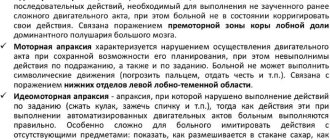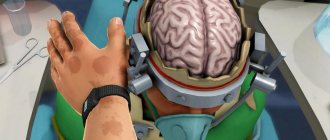- Psychogenic stuttering
- Organic stuttering
As we found out in the article on the physiology of stuttering, its cause is a disruption of the synchronous functioning of the brain centers that ensure the formation and analysis of speech.
Neurophysiology provides a comprehensive explanation of the mechanism of stuttering. Further consolidation of stuttering occurs with the appearance of psychological complexes and logophobia. Now we should consider the reasons for the disruption of the speech centers, which can play the role of a trigger for the appearance of stuttering. The causes of stuttering are divided into psychogenic and organic.
Stuttering in children
Stuttering in childhood is much more common than in adults. Signs of abnormal speech development can be detected already in 2-3 year old children. It is important to differentiate natural intermittent or slurred speech typical of childhood from true stuttering.
Stuttering is understood as frequent interruptions in speech, obsessive repetition of letters or syllables, sometimes entire words; long pauses when the word seems to “get stuck” in the throat.
tonic stuttering in which forced pauses are observed when pronouncing words, and clonic stuttering . Tonic is usually accompanied by tension in the maxillofacial muscles, tongue and larynx during forced pauses. With clonic stuttering, the child repeats the first syllables or letters (usually consonants) of words, while the tone of the muscles involved in speech formation is less pronounced.
Depending on the causes, stuttering is divided into neurotic and neurosis-like.
The neurotic type of defect is observed with pathological changes in the nervous system, in particular in the subcortical areas of the brain, caused by birth trauma, fetal intoxication during pregnancy, viral diseases, cerebral palsy, etc.
The changes may be minor and may not affect the development and mental abilities of children, but may cause overexcitation of speech centers and, as a result, muscle spasms and stuttering.
The neurotic nature of stuttering is revealed during instrumental studies in the clinic.
Neurosis-like stuttering - logoneurosis - manifests itself during normal functioning of the central nervous system. Most often, logoneurosis is a compensatory mechanism of the psyche. It can appear after psychological trauma, stress, due to strong negative emotions that children are unable to express, or their expression is prohibited.
This theory can be supported by the fact that more than 70% of people do not stutter or stutter slightly when speaking alone.
Also, signs of logoneurosis can be the absence of pauses in speech in the following cases:
- when singing, reciting poetry;
- when talking in a whisper;
- when talking with children, animals, inanimate objects;
- in the case when the patient cannot hear himself;
- in conversations with loved ones.
Logoneurosis intensifies when children have to communicate in an unfamiliar environment, with new acquaintances, or speak in front of a group of people.
LiveInternetLiveInternet
Since the times of Plutarch, Demosthenes and Avicenna, it has been known that stuttering is of a psychological nature and that people with certain mental characteristics suffer from it. Today, system-vector psychology determines the true causes, psychological mechanisms, development options for stuttering and effective methods for its treatment.
Often, people who stutter develop logophobia—a fear of speaking, especially in front of a large audience, in unfamiliar places, or in a stressful situation.
Since the times of Plutarch, Demosthenes and Avicenna, it has been known that this disorder is of a psychological nature and that people with certain mental characteristics suffer from it.

Today, system-vector psychology determines the true causes, psychological mechanisms, development options for stuttering and effective methods for its treatment.
According to statistics, stuttering is first diagnosed between the ages of 2 and 6 years. This is precisely the age when intensive development of all innate psychological qualities occurs, the first ranking among peers takes place, character is formed and the script for the entire life of a future personality is laid.
This period of development requires maximum stress on the child’s psyche; changes occur that require psychological effort, searching for a way out of the situation, and playing one’s own specific role among peers. It is at this age that children are especially susceptible and immediately give out the result of any influence on the complex process of development of their vectors - both correct and erroneous.
Stuttering is the result of such erroneous influence, forming an obstacle to the development of innate properties in children of a certain vector set.
Children with oral, anal and visual vectors or a combination of them are capable of reacting by stuttering to incorrect methods of education.
LISTEN, MOMMY, TO A TALE..."
When a little oral speaker begins to learn to speak, he experiments with sounds, syllables and words, trying to understand and master all the capabilities of his erogenous zone. A person who likes to shout, growl, snort, spit and kiss constantly needs his audience; he does not intend to talk to himself, he must be listened to and heard!
At a very early age, he may lisp, whistle, speak incomprehensibly and quickly, not pronounce some sounds or rearrange them, inventing new words and funny expressions.
Filling the needs of the oral vector occurs only when his speech is heard, he thinks by speaking - only his unique verbal intelligence is capable of this.
A little talker can develop and become a great speaker, whose talent lies in the formation of common neural connections among any audience, even a multimillion-dollar audience. They will listen to the speech of such an oral speaker with pleasure, understand and be inspired by his words, remember and retell, quote and admire his ability to captivate the masses.
You want to listen to such an outstanding speaker all the time; it’s not for nothing that the lectures of oral teachers are always overcrowded, his words are simply imprinted in the minds. Listened to the lecture and you mastered the topic.
A highly developed oral performer is simply doomed to great fame, since he is not afraid of either a high podium or a large audience and is ready to speak for hours without stopping. However, unfortunately, today there are only a few such individuals.

A variant of stuttering with prolongation, repetition and distortion of sounds is exactly the case with an oral child. In search of grateful listeners, the little oral speaker directs his verbal attack primarily at his parents. Showing no interest in the child’s story, mom or dad pushes him to look for a more “in demand” topic for conversation, and he begins to invent fables.
Fables about peers, educators, teachers, neighbors and relatives from the lips of an oral inventor sound like the purest truth. The higher the listener's interest in the story becomes, the greater and more vivid details become overgrown with all the details of the story. They're listening to him! What could be nicer?
Parents, listening to children's inventions, believe every word, because the oral word is special, it is impossible not to believe it. But when the truth is revealed, inevitable punishment immediately follows in the form of blows to the lips. Well, so that he doesn’t talk nonsense, so that he doesn’t lie anymore!
A blow to the lips is a super-stressful direct impact on the erogenous zone of a child with an oral vector, the strongest shock that an oral baby can experience.
On the one hand, he wants to talk, his entire psyche requires speaking, he simply cannot remain silent, this causes a strong imbalance in the biochemistry of his brain, but on the other hand, his words can cause such an inadequate reaction from his parents as hitting him on the lips, instead of interest to his stories.
If this situation repeats again and again, the baby begins to stutter, his speech is distorted, he may lisp, burr, whistle or fail to pronounce some sounds. In especially severe cases, speech impairments persist for life, significantly reducing its quality, giving rise to problems in communicating with others and depriving the person of the opportunity to fully realize oneself.
THE QUIETER YOU GO, THE FURTHER YOU'LL GET
Another type of stuttering is difficulty starting a story, interruptions and long pauses between words, and the inability to speak in front of an audience, in an unfamiliar place, or in a difficult situation.
This type of stuttering develops in children with an anal vector. These are special babies, the most obedient and mother-dependent, they are distinguished by their slowness and indecisiveness, the word of their parents is law for them, their own decisions are made with great difficulty and after much deliberation. They learn all skills slowly but thoroughly, they need a role model in everything, they always ask the most clarifying questions to systematize the acquired knowledge at the entrance, that is, if something is not clear to an anal child, he will ask again until will figure it out, only after that he will be able to move further in the process of cognition, regardless of the subject of study, be it buttoning a jacket or solving logarithms.

With adequate development of the anal vector before the end of puberty, such a child in the future becomes an outstanding scientist, analyst, expert in his field, the most highly qualified professional in his field, a talented teacher, capable of making all his students fall in love with his subject.
A little anal child loves to study and please his parents with good behavior, order in his toys or excellent grades; such a child receives the greatest pleasure from well-deserved praise, recognition of his achievements, and the justification of his efforts.
He lives at his leisurely pace, doing everything measuredly and scrupulously, every action he begins must be completed, brought to a point, to the very end, otherwise unfinished work will depress him, remaining in memory for a long time and causing an imbalance in the biochemistry of the brain .
Any hasting, jerking, sudden changes in activities, constant interruptions of his slow speech, deprivation of the opportunity to finish speaking to the end, to finish the story he started, to say everything he intended, result in a persistent speech disorder - the baby begins to stutter.
Such an innate quality as the fear of disgrace forces a stuttering child to avoid situations where it is necessary to speak, especially in front of an audience, even a small one.
The task of explaining homework or answering a teacher’s question in front of the whole class at the blackboard turns into an ordeal when the child falls into a stupor and the ability to express himself is completely lost. The most diligent and assiduous student begins to lag behind in his studies, avoids communicating with peers, and is especially sensitive to ridicule and jokes addressed to him.
It is such a child, in a calm, familiar environment, in the presence of a familiar person, in a relaxed state, who is able to pronounce simple words and sentences absolutely normally without disturbing the rhythm of speech.
IT'S SCARY TO SAY
Another option for the development of stuttering is a speech disorder in children with a visual vector. It is this option that is popularly called stuttering “out of fear.”
A visual child is the most emotional, sensitive and impressionable. Any emotion is experienced by him at the very peak of intensity. If it’s joy, then it’s real delight with appropriate facial expressions, gestures, even jumping, but if it’s trouble, then it’s just the end of the world with bitter tears, sobbing and lamentations. The amplitude is maximum, the ability to switch is instantaneous. From tears to laughter - one moment.

For the normal development of the visual vector, such a baby needs a strong emotional connection with his mother, which provides him with a feeling of security and safety. Developing adequately (without any kind of homemade scarecrows, scary cartoons, cruel fairy tales and the like), a visual child learns compassion and empathy for other people, thus learning to take his fear out into love and empathy.
The most fearful in childhood, he is able to become fearless for the sake of other people; conscious, comprehensive love for people leaves no room for a scanty feeling of fear, filling the maximum visual vector of a high level of development.
Depending on the lower vectors, developed viewers become either carriers of culture (art or education workers), or find themselves in medicine and charity (social workers, volunteers, etc.).
In childhood, during the period of intensive development of vectors, it is the visual child who is especially susceptible to fear; strong emotional stress can cause a child’s speech impairment. Without this, emotional visual speech becomes even more confused, it seems as if he does not have enough air, he is overwhelmed by emotions, leaving no room for normal pronunciation of words. The inability to tell everything you wanted, to share your joy or sorrow, upsets the little viewer even more, depriving the representative of one of the most extroverted vectors of the joy of communicating with family and friends.
Children's fears in adulthood have the risk of developing into persistent phobias or causing panic attacks, significantly reducing the quality of life, depleting the emotional sphere and depriving a person of the ability to fully realize himself in society.
Visual stuttering is the easiest to treat. It is enough to remove the fears that lie at the root of speech impairment, and it will be completely normalized at any age.
THE PROCESS IS REVERSABLE
The development of any vector continues until the end of puberty, that is, up to 12–15 years. During this period, it is still possible to correct the mistakes of upbringing and direct the development of the child’s psyche in a positive direction. When factors that negatively affect the specific psychological qualities of the child are eliminated, the results of adequate upbringing are not long in coming.
Stuttering in any of its forms can remain a thing of the past, giving way to the clean and competent literary speech of a full-fledged member of society, capable of realizing himself and getting maximum pleasure from life.
Even persistent speech disorders that persist into adulthood, losing their psychological background, gradually go away in the process of forming systems thinking after training in system-vector psychology.
Stuttering as a result of exposure to psychological stress of erroneous upbringing is a completely reversible phenomenon, and reversible in the shortest possible time and for life.
Stuttering in preschool children
Signs of stuttering can be observed in children starting from 2-3 years of age.
The rapid development of speech skills observed between 2 and 5 years can leave an imprint on the nature of children’s speech: they can speak quickly, violently, “swallowing” the endings of words, pausing in the middle of a word, and try to speak while inhaling.
At a certain period, these are normal manifestations of the speech learning process. However, children who are prone to stuttering may exhibit the following behaviors:

- Pause frequently while speaking, causing noticeable tension in the muscles of the face and neck.
- Talk little, avoid situations where you need to talk.
- Suddenly interrupt your speech and remain silent for a long time.
- Look depressed and confused.
Early detection of stuttering contributes to better recovery from this defect and reduces the influence of unfavorable psychological and social factors on a small individual.
Stuttering in teenagers
Speech problems may first appear during adolescence. Teenagers, despite their apparent “adulthood,” are very vulnerable. A rapidly growing body, hormonal changes, and a rethinking of values at this age can significantly reduce the body’s defense mechanisms. Speech defects in older children can cause serious psychological complexes, worsen social interactions in a team, affect the educational process and, in the future, the choice of profession.
At-risk groups
Risk groups are those children who are more susceptible to pathology than others. Parents and teachers should be especially attentive in their regard.
The first group is children who have increased anxiety and nervousness. Outwardly, they do not differ from their peers. Very attached to mom. There are emotional swings, as well as sleep and appetite disturbances. Usually these phenomena coincide with the beginning of visiting kindergarten, changing one group to another.
The next group is children with delayed speech development. Their first words appear after 12 months: at about one and a half years, phrasal speech - after three years. Speech is usually incomprehensible, especially to strangers. There are disturbances in sound pronunciation.
The third risk group is children with early speech development. A child begins to pronounce his first words before the age of 1 year, and at one and a half he already speaks in short phrases. At 2.5 years old he actively talks, it is during this period that repetitions appear. A characteristic feature of preschool children is speech during inspiration.
The fourth risk group includes children with a genetic predisposition: with signs of left-handedness due to the peculiarities of the organization of the brain. Other risk factors: a person who stutters in the immediate environment, bilingualism in the family, neurological pathology.
What to do?

If parents have doubts about the normal speech development of the child, they should immediately visit a speech therapist. A speech therapist will be able to determine whether speech abnormalities are within normal limits.
If parents suspect stuttering, it is necessary to minimize stress factors in the child's life, and a trip to a specialist may well be stressful for a preschooler.
How to treat yourself:
- cancel massages, swimming pools, clubs and sections, guests and wild holidays;
- Minimize TV and internet as much as possible. Watch cartoons only that you already know;
- Read books also those to which the child has already become accustomed;
- monitor the sleep and wakefulness patterns, make sure that the preschooler does not “overstay”;
- allow the expression of emotions, including negative ones, do not shame for crying, “whims”, whining;
- talk through stressful situations in a calm environment, discuss them without value judgments;
- analyze whether the psychological situation in the family has changed, regulate relations between spouses or other children.
- speak for the child, describe what is happening, talk about the events and experiences that happened if he finds it difficult to do this himself.
- You should not ask such children questions that require complex answers. There is no need to initiate complex dialogues;
- scold or shame the child for a speech impediment, rush him to answer;
- prohibit the expression of negative emotions;
- focus on speech impediment. Do not ask him to repeat correctly, without hesitation, more slowly, do not talk to him or in front of him about stuttering.

A child who stutters may also be susceptible to symptoms of VSD. Find out everything about vegetative-vascular dystonia in children. The causes of panic attacks and stuttering are very similar. Material about panic attacks here.
What not to do:
In the case of preschoolers, it is a calm, accepting environment in the family and strong contact with parents that are the key points in solving stuttering problems. In adolescents, motivation to overcome the defect is crucial.
First of all, you need to contact a speech therapist . Their professional arsenal includes enough speech exercises that will help your child speak more slowly, relax muscle groups during a conversation, breathe correctly, and more. The speech therapist can also show exercises to parents to repeat at home.
Do not leave the child alone with the speech therapist until you are sure that the specialist has established contact with the baby. Always monitor your child's reaction, interrupt the session if you feel that he is tired, anxious or feels out of place.
It is also recommended to consult a psychologist . Child psychologists, in a playful way, will help a child survive traumatic situations, play out possible dialogues in which stuttering occurs, and see the internal “clamps” that contribute to a speech defect. It would also be useful to talk to a psychologist and the baby’s parents, because a specialist can advise effective methods of mental hygiene and behavior correction.
Physiotherapeutic procedures, massage, physical therapy, reflexology, and breathing exercises are also possible.
The video about childhood stuttering contains real life stories, expert advice and much more:
How we save on supplements and vitamins : probiotics, vitamins intended for neurological diseases, etc. and we order on iHerb (use the link for a $5 discount). Delivery to Moscow is only 1-2 weeks. Many things are several times cheaper than buying them in a Russian store, and some goods, in principle, cannot be found in Russia.
www.neuroplus.ru
How to prevent stuttering from becoming embedded in your child’s speech:
1. In case of “acute” occurrence of stuttering (usually after a fright), favorable conditions should be created for the child as soon as possible to improve the emotional state. This may be a change in the environment in which the injury occurred to another. 2. Intensively monitor the regime - perhaps lengthen sleep and limit the flow of new stimulating information. 3. Parents should try not to outwardly show their concern about the child’s speech. Under no circumstances should you scold your child or force him to pronounce words correctly. Teasing and ridicule are unacceptable. 4. The speech of those around a child who has begun to stutter should be quiet and calm. Try to talk less with your child for a while (sometimes it is even recommended to introduce a silent mode). 5. Offer the child quiet, calm games - drawing, modeling, design - that do not require verbal contact. 6. Form proper breathing in your child (deep inhalation and slow exhalation). The following games are suitable for this:
- Blowing soap bubbles and balloons.
- Blow cotton balls, paper snowflakes off the table, hammer cotton balls into the goal.
- Playing children's wind instruments.
- Moving light toys through the water while swimming (who is faster).
7. Logorhythmic games, marching, clapping to music, dancing, and singing are very beneficial. Teach your child small rhymes with a short line and a clear rhythm of construction. For example, this: Carousel Barely, barely, barely, barely the carousel spun, (the child slowly walks in a circle, reciting the verse) And then around, around, And run, run, run. (runs in a circle) Hush, hush, don't rush. Stop the carousel. (slower and slower) One and two, one and two - that’s the end of the game. (walks and stops) He should carry out all the activities offered to the child with pleasure in a playful way. You should not force a child with speech hesitations to do anything. If you correctly build communication with a child who has begun to stutter, then, most likely, stuttering will not become a permanent disorder, but will disappear without a trace from your child’s speech. In a situation where speech is deteriorating, it is advisable to consult a speech therapist or neuropsychiatrist, and then strictly follow all their advice and requirements.
stuttering in adolescents and adults
Lecture topic 7:
Methods for eliminating stuttering in adolescents and adults
About the peculiarities of the manifestation of stuttering in adolescents and adults.
In adolescence, stuttering smoothes out for many people, and with proper treatment, it can completely disappear from childhood. However, some teenagers experience a relapse or intensification of stuttering at the age of 15-17 years, but, most importantly, a personal reaction to their speech defect sharply manifests itself. Teenagers become shy, avoid peers, contact with strangers, refuse oral presentations, etc. Logophobia may develop - fear of oral speech. Something like a vicious circle develops between the personal reaction and the stuttering itself - one reinforces the other. Such a personal reaction is often regarded as neurotic, emphasizing asthenicity, sensitivity, “pseudoschizoidness,” etc. However, outside of activities associated with oral speech, no asthenia is detected. The “sensitivity” of teenagers who stutter is also selective, and in this they differ from teenagers with sensitive character accentuation. For example, they willingly sing in front of an audience, perform in sports competitions, etc. An adult who stutters experiences frequent speech difficulties and failures, which leads to emotional distress and sometimes to serious psychological trauma, which can lead to a feeling of inferiority , helplessness and other negative personal reactions. Many people who stutter develop internal attitudes that limit the development of their potential (“they will laugh at me,” “I won’t succeed,” etc.) and reduce the quality of social contacts, provoking withdrawal into their own world and the development of self-doubt. Stuttering in adults often leads to changes in a person’s character. Negative consequences lead to isolation, “childish” timidity, lack of an active lifestyle, and indecisiveness. Despite the fact that stuttering appears very rarely in adults, it can arise completely spontaneously. Speech therapists call the cause of the disease very severe mental trauma. Most often, stuttering occurs in childhood at the stage responsible for the formation of speech, that is, during the period of psycho-speech development. By the age of five or six, stuttering very often “goes away,” but there is no guarantee that it will not return later in the form of teenage stuttering. In this case, the disease may acquire stable forms. The chronic, long-term course of stuttering is caused by periodic remissions, followed by more and more exacerbations.
It is difficult to divide stuttering into neurotic and neurosis-like in adolescence. The characteristics of stuttering itself are no longer so clearly visible. A strong personal reaction to one’s defect and psychogenic deterioration of stuttering can be observed in all cases. Neurological symptoms can be compensated by this age. Finally, such a division is no longer relevant because speech therapy assistance is based on its own approaches to the classification of speech defects. Mental trauma rather becomes provoking factors (for example, fear) or precipitating factors (for example, an unfavorable family situation). In some cases, overload of the speech apparatus or the imitation reaction characteristic of children, etc., is pathogenic. The prognosis for stuttering in adolescents is relatively favorable. Logophobia is a consequence of stuttering in adults. It manifests itself in the form of a fear of speaking. It is noted that logophobia intensifies at the most important moments. Over the years, this disease manifests itself in a state of anticipation of communication. A person develops an obsessive fear of stuttering, which accompanies even thoughts in conversation. Fear is caused by past failures. People who stutter begin to replace words with others and do not want to pronounce certain sounds. Therefore, public speaking for these people can be called the most difficult test, since fear increases several times. A person is forced to accompany his speech with long pauses, make repetitions, and stretch out sounds. In adults, stuttering is often accompanied by external manifestations such as grimaces, nervous tics, or involuntary gestures. According to Yu. A. Florenskaya (cited from V. V. Kovalev, 1979), as 90% grow older, stuttering sharply decreases or disappears altogether. Treatment of stuttering should be carried out by specially trained specialists and represent a single complex of speech therapy and psychotherapeutic methods. Treatment takes several months, after which the person will be able to communicate normally again. Since this disease is in the nature of neurosis, it is treated exclusively by psychological methods. An important point in the treatment of stuttering is the person’s desire for recovery. The patient needs to fully open up to the specialist.
studfiles.net
Stuttering: What Parents Should Know
Many parents quite often face such a difficult problem as stuttering in a child. This disease means a violation of the fluency of speech and its pace. This disease is caused by convulsions in the speech apparatus or in its various parts: tongue, lower jaw, lips, palate. It is very simple to determine that a child or adult stutters: when speaking, he is forced to stop and repeat individual words or syllables. Most often, stuttering begins to appear in children in one age period: from 2.5 to 5 years. Doctors attribute this to the fact that it is at this age that speech begins to actively develop. It is very difficult for people who stutter to speak in public, but in private they, on the contrary, can speak without hesitation, especially if they are emotionally involved in something. It is worth noting that stuttering occurs several times more often in boys than in girls.

Stuttering is caused by spasms in the speech apparatus or in various parts of it.
Behavior of parents of a child with speech hesitations:
- Reduce the amount of incoming information as much as possible (exclude mass entertainment events, books and films that are not age appropriate).
- If a child has problems with sound pronunciation, direct efforts to eliminate them (perhaps the root of stuttering lies in the difficulty of pronouncing sounds correctly).
- If a child who has started to stutter prefers to use his left hand, then there is no need to retrain him. You can only offer to use your right hand in an unobtrusive manner (put cutlery on the right, hold out pencils to your right hand). It is impossible to prohibit the use of the left hand.
- If a child’s stuttering is provoked by the stuttering of someone close to him, reduce their communication (or even better, interrupt it for a while).
- If stuttering occurs in a child from a bilingual family, one language should be removed from use. Until the moment when the child’s speech norms of one language settle down. Usually this happens by 5-6 years.
Classification of stuttering
With short-term muscle contraction, clonic stuttering occurs, that is, involuntary repetition of individual syllables and sounds. If the muscle spasm lasts longer, then tonic stuttering is observed. In most cases, they speak of a mixed form of stuttering, when both types of this disorder occur. Also, in addition to spasms of the speech apparatus, muscle spasms of the limbs and face may also occur.
A disease such as stuttering is also divided into neurotic and neurosis-like forms. Impairments in motor skills and articulation are characteristic of the neurosis-like form, and besides, children with this form of stuttering quite often begin to speak late. If a child suffered a strong fright once or has chronic fright, then such stuttering is called neurotic. Stress or nervous shock can also cause this form of speech impairment.
All of these forms of stuttering are characterized by tension, anxiety and fear of speaking. When a person tries to overcome a stutter, facial grimaces or unnatural tics may occur.
Degrees of stuttering. Stuttering is divided into several degrees of severity, which depend on the duration of the seizures and their intensity: mild degree - this degree of the disease is characterized by minor stuttering that does not interfere with communication, but it is at this degree that parents need to see a doctor; medium degree - when speaking, hesitations are noticeable and prevent you from saying a sentence to the end; severe degree - hesitation is observed in all forms of speech, and it is very difficult for a person to speak, and already at this degree additional movements of the face or neck may be added.
One of the main causes of stuttering in an adult or a child is a weakened nervous system. The most common cause of stuttering also includes sudden fear or unfair, rude treatment of a child. Stuttering can occur due to a change in life conditions for the worse. Children who begin to speak early enough may also develop this disease. And vice versa, if a child has not spoken for a long time, then later, after speech begins to develop rapidly, stuttering may appear. If a child has slow motor skills and does not take care of himself well, this disease may also occur.

One of the methods for treating stuttering in children is silence.
Stuttering can also be caused by hereditary predisposition, difficult pregnancy, and frequent illnesses in the first year of a child’s life. And although outwardly such children look healthy, upon additional examination, they usually reveal increased intracranial pressure, a tendency to seizures and changes in reflexes.
Nervous tic
This is the name for involuntary sharp muscle contractions, twitching of a certain part of the face or limb. Most often, an eye, eyebrow, or lip can twitch independently of a person’s will, but it happens that a leg or arm behaves this way.
The extrapyramidal system of the brain is responsible for automating human movements. Its overexcitation, excessive activity contributes to the occurrence of tics. The reason for this phenomenon, among other things, can be a short-term shock and permanent psychological problems.
The psychological factors of nervous tics are as follows:
- overexcitement;
- overvoltage;
- irritation;
- chronic or acute stress.
Why does the eye twitch most often? The right one symbolizes the masculine principle and is responsible for the vision of the world, and the left symbolizes the feminine principle and its responsibility for self-perception. Tic is a response to reluctance to see an object or subject. That is, it is unpleasant and even painful for a person to see and perceive certain visual information.
The same Liz Burbo claims: a nervous tic is evidence of many years of restraint and the fact that a person can break at any moment. The accumulated tension is looking for a way out. This is not only the suppression of aggression and anger. An individual can harbor fear or anxiety for years, the fear of disgracing himself and losing his significance.
Of great importance in the search for causes is the metaphysical significance of the area where the tic arose. So, its appearance on the face indicates the fear of losing it, that is, reputation, respect in society.
Another famous psychologist, founder of the self-help movement, Louise Hay, says that the eye twitches because a person is insecure and has paranoid tendencies: it seems to him that someone is constantly watching him.
According to another famous specialist, Valery Sinelnikov, a therapist, psychologist, and psychotherapist, most often a nervous tic affects children. And the main culprits of this pathology are, again, parents who lack unconditional love for their child. They have no particular desire to take care of him, but a sense of duty forces them to do so.
Such mothers and fathers lament the negative circumstances that, in their opinion, arose with the birth of the baby: moral, material and other problems. They harbor a grudge against the child because he prevents them from realizing their full potential. This leads to claims and hatred both towards the child and towards each other, and constant conflicts.
You should understand: the health of children depends entirely on the emotions and thoughts of their parents.
A person suffering from a nervous tic needs to realize the reasons for his fear and, with the help of a psychologist, bring the negativity out of the subconscious into consciousness. If this can be done, then the physical symptoms - twitching - will gradually disappear. There is an excellent attitude towards healing: “I am accepted by life, there is no danger, everything will be fine.”
Main signs of stuttering
The main signs by which stuttering can be diagnosed include the following factors: • extra sounds are used before individual words, for example, a, and; • forced stops in the middle of a word or phrase; • there are certain difficulties before starting to speak; • repetition of whole words or syllables at the beginning of a phrase; • if we talk about a child, he may refuse to speak, and this behavior can last for several hours or even a day, and then he begins to speak, but difficulties are already noticeable; • tense appearance of the neck and face; • speaks in an unexpectedly loud voice.
Treatment of stuttering in children 3 years old. If a child has a stutter, then under no circumstances should the disease be left to chance and ignored by doctors. It is a big mistake of many parents to think that stuttering will go away on its own over time. The approach to the treatment of stuttering must be comprehensive. It is important that the necessary therapy is prescribed by a qualified speech therapist. The sooner treatment is prescribed, the faster it will produce positive results. It is necessary to closely monitor the child, and at the first signs of stuttering, contact a specialist, because if you delay treatment, it will be much more difficult to fight the disease in the future.
It is also worth mentioning that in order to successfully treat stuttering, parents will need to work quite closely with a speech therapist for some time, and therefore they need to approach the issue of choosing a doctor very responsibly. Treatment cannot be successful if the specialist and parents cannot find a common language and there is no trust in this doctor.
Classes with a speech therapist help get rid of the disease
Very often, stuttering occurs in very active and easily excitable children. Therefore, one of the important foundations for the effective treatment of this disease is a properly organized daily routine for the child and its strict adherence. For example, with regard to everyday play activities, you need to make sure that sitting in front of the TV and watching cartoons does not take up most of the child’s time. Prolonged exposure to a TV screen can, on the contrary, contribute to the appearance of excessive excitability. The consequence may be even more severe stuttering. It is best to keep your child occupied with educational games, of which there are a large number today.
When treating a child's stuttering, it is important to approach the issue of his sleep correctly. It must be remembered that a child under seven years old should sleep about eleven hours at night, and around two during the day. Such daytime sleep is very important for the child’s body, as it has a positive effect on the state of the nervous system. Daily walks in the fresh air should not be ignored, because they play a very important role for a growing child’s body. The time spent outdoors should be at least two hours per day.
The main process of treating stuttering in a child occurs in classes with a speech therapist, but since the doctor does not have the opportunity to constantly be near the child and monitor the correctness of his speech, this task is shifted to the parents. In no case should you immediately reprimand the child if he again said this or that word incorrectly; you just need to finish the word correctly, without focusing too much on it. If an already advanced form of stuttering is observed, then many speech therapists use a specific technique of complete silence. The child can only talk during classes with a speech therapist, and the rest of the time he must remain silent. If necessary, you can speak, but only in a whisper. The essence of this technique is that with prolonged silence, the child’s reflex to stuttering is gradually suppressed, because during classes his speech is controlled, and since the rest of the time he is silent, therefore, at a subconscious level, a conditioned reflex will be developed that will be responsible for correct speech. Parents of a 3-year-old child who must perform such a doctor’s task must show all their imagination to turn such silence into an exciting game, with various interesting incentive prizes.
Parents must follow several basic rules that will help effectively treat stuttering in a child and for its prevention. The first thing is to never discuss his stuttering problem in front of your child. The baby hears and understands everything, and therefore can be very painful when adults discuss their shortcomings. The second rule is the need to monitor your own speech in the presence of a child. First of all, you need to speak calmly, expressively and slowly. You need to remember that how your child speaks depends on how your speech is delivered. The atmosphere in the house should be calm and benevolent, the child should feel the love of his parents. A showdown should only take place without the presence of a child, since frequent quarrels can lead to the development of stuttering in a completely healthy child.

Breathing exercises will help adults overcome the disease
Treatment of stuttering in adults and adolescents. Conducting therapeutic therapy for stuttering in adolescents is very important, since it is of great importance for personality formation and social adaptation. It is important not to delay treatment and carry it out in a timely manner. Adolescence has its own characteristics, so they must be taken into account when conducting therapy. Unlike children of primary school age and very young children, who are confident in the help of adults, a teenager wants to do everything on his own. If a child develops a stutter during adolescence, this can exacerbate the problem of loneliness and lack of contact with peers. Treatment of stuttering in adolescents will help not only get rid of existing complexes, but also get closer to their parents.
To help an adult get rid of stuttering, there are a large number of different methods that can be divided into the following groups: psychotherapeutic, speech therapy, psychological, logopsychotherapeutic, medication, physiotherapy, socio-rehabilitation and complex. For treatment to be as effective as possible, it is best to use several methods in combination. The most common methods are breathing exercises, which consist of exercises to train the diaphragm and deep breathing. After such exercises, breathing becomes freer and, therefore, the voice becomes more natural.
Also, some decide to treat stuttering in such an unconventional way as hypnosis. How can you get rid of stuttering using this method? The doctor conducts a hypnosis session and instills self-confidence in the person. This method has many disadvantages, for example, side effects such as insomnia, headaches and memory impairment. Also, not every person is susceptible to hypnotic suggestion, which means that this method will not work on him. In addition, hypnosis allows you to achieve very unstable results, so it should be used only in combination with other treatment methods.
Non-traditional massage treatment methods include acupressure. The effect of this technique will depend on how advanced the stuttering is. Acupressure can be used at any age. The course of treatment is quite long, so even if there are improvements after the first session, you cannot quit right away. Initially, the procedures are carried out daily, and then every other day. Such a massage must be carried out by a specialist who is fluent in the technique of acupressure. Before the procedure, the person must be calm and relaxed.

Herbal teas are suitable for a calming effect on the nervous system.
There are options for using special medications during the treatment of stuttering. These can be either anticonvulsants or tranquilizers. A significant disadvantage of using these medications is the presence of serious side effects, which is why many doctors oppose their use in the treatment of stuttering. Instead of such drugs, you can use folk remedies, for example, decoctions of various herbs that have a calming property (motherwort decoction).
How should parents behave if their child has a risk factor for stuttering:
- Observe routine moments (sleep, nutrition, walks - in accordance with the child’s age).
- Avoid emotional overload (frequently visiting places where large numbers of people gather); excessive physical activity (at the first signs of fatigue, allow the child to rest, do not press on him).
- Monitor a favorable emotional climate in the family. Do not allow yourself to scream or swear in the presence of your baby.
- Try to ensure that the demands placed on the child by different family members do not contradict each other.
- If a child has fears (darkness, loneliness, closed space), do not teach him or her to be brave under any circumstances. Don't provoke fears by showing movies or intimidation. If fear arises, allow the child to sleep in dim light, stay near him for a while when falling asleep. If the fear does not go away for a long time, you should contact a neuropsychiatrist.
It is very important for parents to control their own speech - after all, for the baby it is a role model.
Treatment and prevention of stuttering using traditional methods
Most people wonder: how to get rid of stuttering on your own? Today, there are many different options for exercises for stuttering that can be easily performed at home. Today, the computer correction method is also very popular, which means that a person receives a certain set of programs and independently studies them at home, for example, Breath Maker.
Traditional methods are suitable both as treatment and as prevention, so if a person trusts previous generations, then you can try a few simple recipes. To normalize speech function, as well as for a calming effect on the nervous system, the following collection is successfully used: lemon balm, licorice, calendula, birch leaves and sweet clover. The prepared decoction can only be used by adults several times a day before meals. There is an option for another herbal collection with similar functions: chamomile, oregano, motherwort, anise, St. John's wort and lemon balm.
Aromatic oils are also used to treat stuttering, for example, pine, rosemary, basil, bergamot, rose and sandalwood oil. All these oils have a calming effect and relieve stress and fear. You can carry out procedures with achromatic oils up to four times a day; if you use them more, this can provoke allergies. You can add aromatic oils when taking a bath. Suitable oils include lavender, sage, thyme, geranium and wormwood.
symptomtom.org
How does stuttering occur?
Speech disturbances during stuttering are caused by a spasmodic state of the structures that take part in the formation of speech - namely:
- language;
- soft palate;
- lips;
- muscular apparatus of the larynx.
Anti-stuttering exercises are aimed at eliminating these spasmodic contractions.
Spasms happen:
- articulation (the tongue, soft palate and lips suffer);
- vocal cords (the larynx apparatus suffers, with spasmodic contractions of its muscles a condition similar to hiccups occurs);
- respiratory - with them, breathing “gets confused”, a person cannot cope with it, a feeling of lack of air is created (although there are no objective prerequisites for complaints about such a violation).
Spasmodic contractions occur due to the fact that in the motor speech centers located in the brain, excessive excitation of the nervous structures is formed, which spreads to neighboring respiratory centers and centers responsible for emotions.
Speech therapy examination of teenagers with stuttering
The speech therapist’s acquaintance with the teenager is preceded by collecting information from the parents. For this purpose, there is the following questionnaire with questions regarding the speech development of a teenager, the characteristics of his illness and personality. The range of interests of the patient and the results of previous treatment are clarified. The speech therapist pays attention to how stuttering manifests itself depending on the situation. All this work is aimed at getting to know the teenager in detail in order to correctly correct the personality and speech defect in the future. In this case, it is also necessary to take into account the individual characteristics of the teenager. When collecting speech anamnesis data, a first explanatory conversation with parents is also carried out.
SPEECH HISTORY (according to parents and patient)
How early speech development proceeded - humming, babbling, first words, phrases.
Time of appearance of stuttering, its probable causes.
How did the stuttering progress: did it remain at the same level, did it intensify, or was it undulating?
As currently spoken in the following situations:
in family, with friends, when answering in class, in unfamiliar surroundings.
Is there a fear of speech?
How was learning school material going?
What character traits does the patient have, and is there a desire for treatment?
What is speech heredity?
Where, when, how much I studied and received treatment for stuttering, with what result.
After collecting anamnesis, the speech therapist conducts an initial speech therapy examination of adolescents. It is carried out according to a questionnaire, where all the characteristics of the teenager are noted and the full characteristics of the speech disorder are recreated.
pedlib.ru
Treatment of stuttering in adults and adolescents
Stuttering is a disease of the central nervous system when a person stumbles while speaking, which is caused by spasms in the muscles of the speech apparatus. Most often children experience this disease. In most cases, its duration ranges from a couple of months to several years, after which it may go away on its own. Thus, treatment for stuttering in children is not always necessary. In adults and adolescents, as a rule, dysfunction of oral speech is of a mental nature, less often caused by injuries and physical diseases. Treatment of stuttering in adults and adolescents is often a longer and more complex process compared to working with children.
Treatment methods for stuttering
There are hardware and software systems for speech therapists:
- logotherapeutic;
- biofeedback-health;
- performing correction of psycho-emotional state;
- breathing simulator BIOCOMMUNICATION.
The method of treating stuttering in adults and adolescents depends on the cause of the disease and the type of stuttering.
Currently, the most popular and effective way to combat stuttering is to conduct classes with a speech therapist. A person who stutters turns to a specialist, who selects their own treatment methods for him, based on the individual characteristics of the patient. Speech therapists use both traditional and proprietary methods. A program is drawn up for the treatment of stuttering in adults and adolescents, sessions are scheduled when the patient needs to come to an individual lesson with his specialist.
Of course, attending only classes with a speech therapist is not enough to solve speech problems. Treatment of stuttering at home has found widespread use. You can perform traditional exercises (for example, the famous “Strelnikova Breathing Gymnastics”), take medications (drugs that inhibit the psyche. Their action is aimed at stopping convulsions).
Quite often, when treating stuttering in adults and adolescents, a speech therapist prescribes acupressure.
Modern methods of treating stuttering are popular, which are based on the use of devices and computer programs. With their help, it is possible to effectively treat stuttering in adolescents, since they are characterized by a high degree of motivation, making treatment sessions an exciting game.
Treatment of stuttering in adolescents
Let's consider one of the common methods of treating stuttering in adolescents. The full course lasts 1 year and is carried out in a small group. Together with the teenager, one of the adult family members must master the technique, therefore one of the family members must be present at all classes and speech exams.
The first step in correcting stuttering is a consultation, during which the method of treating stuttering in adolescents will be described in detail. It is advisable that everyone who lives with the teenager, as well as those who often communicate with him, come to this consultation.
Main course
The main course of treatment for stuttering includes 2 preparatory classes, lasting 45 minutes, 15 main classes, lasting 2 hours each. During the basic course of treatment for stuttering, a teenager will be able to master the skills of fluent speech without stuttering.
Maintenance course
In addition, support and educational microcourses are included in the treatment. Such classes are held throughout the year once every 2-3 weeks in a small group of 2-3 people. The duration of each lesson is 1 hour. If necessary, an individual lesson lasting 1.5 hours is provided. Supportive microcourses are necessary in order to automate new speech skills and cultivate bold speech behavior.
Thanks to educational microcourses, a teenager gradually moves from slow speech “with a hand” to natural intoned speech “without a hand.” The result of treatment is the teenager’s mastery of speech without stuttering, natural, intonation-colored at a normal pace and not accompanied by the fingers of the dominant hand. During the entire course of treatment for stuttering in adolescents, it is planned to provide remote support and organize functional training, during which speech and communication skills are trained in all possible life situations. After completing the full course of treatment for stuttering in adolescents, which takes 1 year, the child must be under the mandatory supervision of a speech therapist for the next year.
luxmama.ru
Parents' speech should be:
- Smooth, slow, emotionally expressive. Do not rush or raise your voice when communicating with your child.
- Do not use onomatopoeia or distorted pronunciations of words in your speech. Your speech should be clear and correct.
- When communicating with your baby, try not to use complex speech patterns or long constructions. Communicate using phrases that are easy to understand.
- Do not put pressure on your child, urging him to respond faster to your words.
- Under no circumstances should you scold or reproach your child for an incorrect answer.











